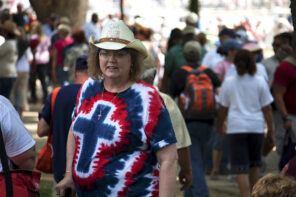This weekend, NPR’s Scott Simon invited Mary Eberstadt, a senior fellow at the Ethics and Public Policy Center, to discuss what lies ahead for the Catholic Church under Pope Francis. Eberstadt used the opportunity to promote the thesis of her forthcoming book, How the West Really Lost God: A New Theory of Secularization.
Despite its title, Eberstadt’s book—and her interview with Simon—peddled a well-worn idea. As Eberstadt herself put it,
Over time, the churches that have tried to lighten up the Christian moral code and put forth sort of a kindler, gentler version of Christianity as they see it, have not done well. They have not done well demographically and they haven’t done well financially. Churches that stick to orthodoxy do better over time because in part it’s only those churches that tend to create families that can be of size and carry on the Christian tradition.
This harkens back to Dean Kelley’s 1972 book, Why Conservative Churches Are Growing, which argued that liberal denominations were losing a battle of ideas to stricter, more conservative communions.
The new twist here is Eberstadt’s argument that “orthodox” churches are winning not by directly drawing converts from liberal churches, but through the sheer power of birth rates.
This isn’t the only dubious argument Eberstadt puts forth. She argues, for example, that the Catholic Church is the guardian of a truth unchanged since the death of Christ, a claim that would certainly be met with bemusement by historians of Christianity. For that matter, there are plenty of mainline Protestant denominations that would take issue with being labeled less-than-orthodox. And even relatively conservative Catholics like the newly-minted Pope Francis would agree that the “Christian moral code” involves a commitment to peace and social justice, which Eberstadt seems to ignore in favor of questions of sexual morality. (To be fair, Simon didn’t ask her about such issues.)
But the heart of Eberstadt’s argument is demographics, and just about every piece of social research released in the few years undermines that argument.
For example, while it’s true that Catholics tend to be more fertile than mainline Protestants, the topline numbers mask a complex underlying situation. According to the Pew Forum’s Religious Landscape Survey, since 1972, Catholics have been about 25% of the total population in the United States. However, white Catholics have been in serious decline during the same period. It’s only lopsided margins of Catholics among immigrant groups (especially Hispanics) that has propped the Church up in the past forty years. Hispanic Catholics have a high fertility rate (2.75 children per couple), second only to Muslims in the U.S. Non-Hispanic Catholics (2.11 children), meanwhile, look a lot like moderate Protestants (2.01) and liberal Protestants (1.84).
Here’s the kicker: Catholics are overrepresented among immigrants—again, especially Hispanics—who still account for a disproportionate number of all births in the U.S. But the overall fertility rate has crashed since 2007—led by a sharp decline in immigrant fertility, particularly among Hispanics.
What’s changed since then? Hint: it’s not a radical change in the moral teachings of the Catholic Church. In fact, a few peaks and valleys aside, the US birth rate has been pretty stable since 1970, and in recent years everyone has had fewer children. So if we’re going to find an explanation of church declines, we’ll have to look somewhere else. Conservatives having more babies than liberals just isn’t going to suffice.
Another plausible explanation is religious out-migration. All American faiths receive new members from some groups and lose a few to others. In recent years, moderate and liberal Protestants have lost more to conservative Protestants and the Catholic Church than they’ve picked up. As if that weren’t bad enough, moderate and liberal Protestants—that is, the mainline churches—have lost the most members to the ranks of the religiously unaffiliated, the so-called “nones.”
Eberstadt had a ready explanation of this phenomenon:
If you water down Christianity, just telling people to be nicer to each other, or to do what the majority seems to want to do, people pretty quickly conclude that it’s easier to be nice at home. Why should they go to church?
Which sounds reasonable enough: who wants to listen to wishy-washy platitudes, or attend a religious-flavored social activist club?
But when you dig down into the numbers, what you find is that not many churches—liberal or conservative—are growing very much. The Southern Baptist Convention, for example, has essentially flatlined over the past few years.
Social scientists will tell you that while mainline Protestants might be leading, evangelicals aren’t far behind on the decline curve. And when you ask the people who actually have left the church, a distinct picture emerges. Here’s what Michael Hout and Claude S. Fischer concluded in their landmark 2002 study of the nones:
Christian decline appears to have political content: Organized religion linked itself to a conservative social agenda in the 1990s, and that led some political moderates and liberals who had previously identified with the religion of their youth or their spouse’s religion to declare that they have no religion. Had religion not become so politicized, these people would have gone on identifying as they had been and the percentage of Americans preferring no religion would have risen only [modestly].
Hout and Fischer released a study this year with Mark A. Chaves, which seemed to show that the trend continues. Their original findings have been partly confirmed by the Pew Forum, which found in 2012 that the nones overwhelmingly saw religious organizations as “too focused on rules,” “too concerned with money and power,” and “too involved in politics.” Not on the list: a desire for a stricter moral code. Along with another major study conducted by the Public Religion Research Institute, the Pew Forum found that Americans without religious affiliation strongly identified with the Democratic party and liberal social positions.
All of which tends to indicate that Hout and Fischer were right when they said that disaffiliation is driven by a rejection of the religious right. It seems perverse to say that members of liberal denominations show their displeasure with religious conservatism by walking away from their own churches, but that seems to be exactly what’s happening.
On the surface, this might seem like a point in Eberhardt’s favor. “Orthodox” churches keep their members in line; liberal ones can’t. But how then to explain that the most liberal of the liberal denominations—the Unitarian Universalist Association—is in fact growing? For that matter, one might argue that Catholics have more to lose by alienating liberals than they have to gain by growing conservative families. The bishops seem to have decided just that when they put together their “Catholics Come Home” a d campaign showing a “kinder, gentler version” of the faith.
The Catholics might have more to lose in a more abstract sense, too. At a certain point, you have to ask the questions Scott Simon didn’t: how orthodox is too orthodox? At what point does the pursuit of moral structure go from coherence to exclusionary for its own sake?
In fact, Simon didn’t ask a lot of questions. None of the points I’ve outlined here are obscure—religion journalists here and elsewhere have been covering these trends for some time. Nor are they particularly controversial. In fact, aside from a few nuances, what I’ve reported is essentially the consensus of American demographers of religion.
Nor is this material trivial. The story of the rise of the nones in particular is vast, rich, and complex. Its social and political ramifications continue to unfold. Admittedly, there’s only so much room in a five-minute interview, but as it was, NPR wound up giving a platform to a shallow version of orthodoxy, and missed the opportunity to challenge some implausible assertions. That’s not an outcome any news show, or its audience, wants or deserves.




